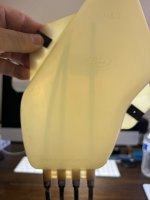That would be why there ain’t one on my 77. And all this time I was thinking that a PO had yanked some stuff off the fuel system, being as the cobbled together mess of fuel lines between the tanks and fuel pump.Well, yeah. The D3TZ-9A091-A, Tank Assembly, Fuel Tank Vent Expansion was gone by 1977. So it wouldn't be in a 77 Shop Manual. That makes sense.
Randy














